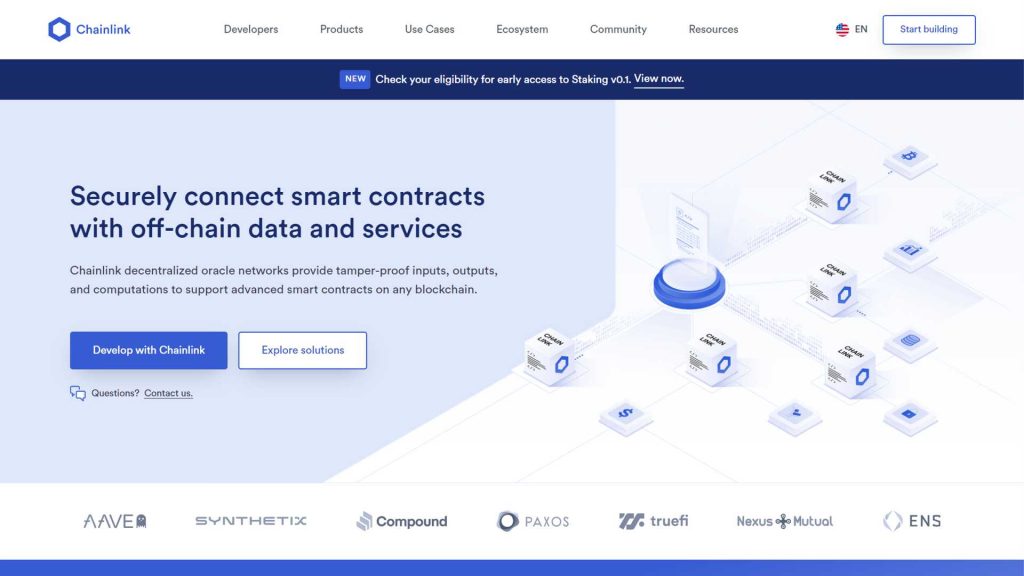What Is Chainlink – 5 Ways It Impacts the Crypto World?
Chainlink links smart contracts and external data sources, delivering real-time data to smart contracts established on blockchain networks. Smart contracts have grown in popularity due to their openness and independence. Users can sign contracts with one another without having to interact with a centralized authority. And once the contract terms are met, the contracts are immediately executed. After understanding what is Chainlink, let us explore other factors about it.
The main issue is that these contracts frequently require information from real-world platforms to operate successfully. Their decentralization suffers as a result. And if they pursue the right decentralized path for execution, the process takes longer to complete. Chainlink tackles the problem in this case by building a connection between the blockchain industry and real-world data.
What is Chainlink (LINK)?

Chainlink is a decentralized oracle network that gets real-time data from outside sources like APIs and sends it quickly and securely to smart contracts.
Chainlink history
Chainlink was created in 2017 by SmartContract, a for-profit corporation. The whitepaper was published in September 2017 by the company’s co-founders, Sergey Nazarov and Steve Ellis. The company raised $32 million through an initial coin offering by selling 35% of the total supply. The other 35% of tokens are dedicated to encouraging node operators, with SmartContract receiving 30% of the overall supply for continued project development.
How Does Chainlink Work?

Chainlink is committed to providing users with dependable and trustworthy real-world data via a network of nodes. Chainlink has broken down this process into three simple steps to ensure that users receive timely and accurate updates.
Oracle selection
When a smart contract requests external data, an event is registered on the Chainlink protocol. These requests are linked with oracles that can supply the necessary information. Users can then deposit their LINK tokens to proceed with the request.
Data reporting
The oracles gather real-world data from external sources based on the smart contract’s specifications in this step. The data is subsequently sent to smart contracts formed on the Chainlink network.
Result aggregation
In this step, the data is sent to a contract for aggregation so that it can be checked. The aggregation contract uses the data from the oracles to make a weighted score.
Understanding the Different Kinds of Chainlink Smart Contracts
Smart contracts are classified into three types.
Aggregating contracts
The aggregation contracts produce an accurate result using the information from different oracles.
Order-matching Contracts
When the Order-Matching Contracts send requests, the node operators bid on them. The algorithm then determines the appropriate number of nodes to fulfill the request.
Reputation contract
Reviewing its track record validates the oracle provider’s validity and performance. It considers various parameters, such as average response time, the total number of completed requests, and the number of LINK tokens staked by the Oracle provider. Based on this information, untrustworthy and disreputable nodes are eliminated.
How Do Chainlink Nodes Verify Data?
Chainlink nodes collect data from external sources on their own and do not store it on the blockchain. Chainlink nodes are made up of two key components.
- Chainlink core – Chainlink core provides assignments to the Chainlink Adapter in response to smart contract requests
- Chainlink Adapter – The Chainlink Adapter can read and write data on the blockchain received from nodes. It acts as a link between external data and nodes
With the support of Chainlink Core Software, the Chainlink core makes the programming language simply accessible for a real-world data source. After receiving the request, the application programming interface (API) retrieves data from the source. The Chainlink aggregating contract then checks data collected from many sources.
If most nodes produce one answer and a few deliver a different one, the system considers the various replies incorrect. The aggregating contract can collect data from either a single node or a group of nodes. The data is subsequently sent to the blockchain network for processing.
Defi and Chainlink
Because of the widespread usage of decentralized finance, high-quality oracle services have grown in popularity (Defi). Most of these initiatives require external data to execute their smart contracts fully. These platforms are vulnerable to cyber-attacks if they rely on centralized oracles for data compilation.
Many Defi projects have already suffered as a result of adopting such oracles. Chainlink is the ideal answer because it provides a decentralized solution for data collection for Decentralized Finance apps. It provides the most accurate data in the shortest amount of time.
Who are LINK Marines?
LINK Marines are Chainlink project community members who are either node operators or token holders. These community members can interact with one another via various platforms. They can also get information about the most recent project updates.
What is LINK Token Used for?
The Chainlink project’s native token is LINK. It has a market cap of $3.7 billion and a circulating supply of 491 million coins. The total supply is 1 billion tokens. The remaining tokens will be distributed to node operators gradually.
Staking
Node operators must stake their LINK tokens when bidding for a data request. They might be rewarded for giving accurate data. They may lose their tokens if they engage in malicious activity.
Transaction fee
One of the primary applications for LINK tokens is transaction fees. Users must pay the LINK token when they initiate a request for external data. A percentage of the transaction cost is distributed to node operators to deliver reliable data. To keep the supply going, the leftover tokens are burned.
Conclusion
Chainlink contributes significantly to decentralized finance by serving as a link between blockchain and other data sources. It uses oracles to offer correct external data without compromising network security.



